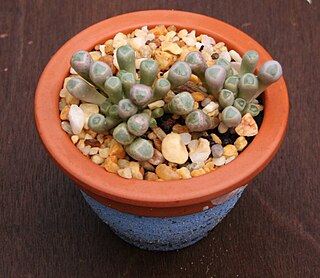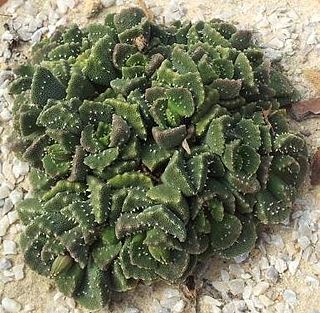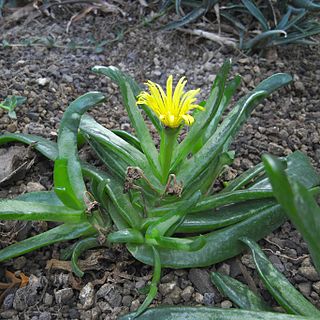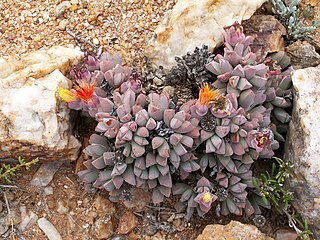
A cactus is a member of the plant family Cactaceae, a family comprising about 127 genera with some 1750 known species of the order Caryophyllales. The word cactus derives, through Latin, from the Ancient Greek word κάκτος (káktos), a name originally used by Theophrastus for a spiny plant whose identity is now not certain. Cacti occur in a wide range of shapes and sizes. Although some species live in quite humid environments, most cacti live in habitats subject to at least some drought. Many live in extremely dry environments, even being found in the Atacama Desert, one of the driest places on Earth. Because of this, cacti show many adaptations to conserve water. For example, almost all cacti are succulents, meaning they have thickened, fleshy parts adapted to store water. Unlike many other succulents, the stem is the only part of most cacti where this vital process takes place. Most species of cacti have lost true leaves, retaining only spines, which are highly modified leaves. As well as defending against herbivores, spines help prevent water loss by reducing air flow close to the cactus and providing some shade. In the absence of true leaves, cacti's enlarged stems carry out photosynthesis. Cacti are native to the Americas, ranging from Patagonia in the south to parts of western Canada in the north—except for Rhipsalis baccifera, which also grows in Africa and Sri Lanka.

Peperomia is one of the two large genera of the family Piperaceae. It is estimated that there are at least over 1,000 species, occurring in all tropical and subtropical regions of the world. They are concentrated in northern South America and Central America, but are also found in Africa, southern Asia, and Oceania. The exact number is difficult to tell as some plants have been recorded several times with different names and new species continue to be discovered. Peperomias have adapted to many different environments and their appearance varies greatly. Some are epiphytes or lithophytes, and many are xerophytes (drought-tolerant) either with thick succulent structures or with underground tubers (geophytes). Most species are compact perennial shrubs or vines.

The Aizoaceae, or fig-marigold family, is a large family of dicotyledonous flowering plants containing 135 genera and about 1800 species. They are commonly known as ice plants or carpet weeds. They are often called vygies in South Africa and New Zealand. Highly succulent species that resemble stones are sometimes called mesembs.

Dudleya virens, the green liveforever or bright green dudleya, is an uncommon species of perennial, succulent plant in the family Crassulaceae, native to several coastal southern California and Baja California locations.
A storage organ is a part of a plant specifically modified for storage of energy (generally in the form of carbohydrates) or water. Storage organs often grow underground, where they are better protected from attack by herbivores. Plants that have an underground storage organ are called geophytes in the Raunkiær plant life-form classification system. Storage organs often, but not always, act as perennating organs which enable plants to survive adverse conditions.

Bergerocactus emoryi is a species of cactus, known commonly as the golden-spined cereus, golden snake cactus, velvet cactus or golden club cactus. It is a relatively small cactus, but it can form dense thickets or colonies, with the dense yellow spines giving off a velvety appearance when backlit by the sun. From April to May, yellow, green-tinged flowers emerge, which transform into reddish, globular fruit. This species is native to the California Floristic Province, and is found in northwestern Baja California and a small part of California, in San Diego County and on the southern Channel Islands. Where the Mediterranean climate of the California Floristic Province collides with the subtropical Sonoran Desert near El Rosario, hybrids with two other species of cacti are found. It is the sole member of the monotypic genus Bergerocactus, named after German botanist Alwin Berger.

Fenestraria is a genus of succulent plants in the family Aizoaceae, native to the Namaqualand in Namibia.

Aloinopsis is a genus of ice plants from South Africa.

The Succulent Karoo is a ecoregion defined by the World Wide Fund for Nature to include regions of desert in South Africa and Namibia, and a biodiversity hotspot. The geographic area chosen by the WWF for what they call 'Succulent Karoo' does not correspond to the actual Karoo.

The bush vlei rat or Karoo bush rat is a species of rodent in the family Muridae. It is found in Namibia and South Africa. Its natural habitat is temperate shrubland. The Karoo rat uses behavioral adaptations to cope with the dry arid climate. It is a medium-sized rodent with a dark pelage on top and lighter underneath. It has light colored feet and a dark tail. The rat may have light colored fur around its eyes and the back of its ears.

In botany, succulent plants, also known as succulents, are plants with parts that are thickened, fleshy, and engorged, usually to retain water in arid climates or soil conditions. The word succulent comes from the Latin word sucus, meaning "juice" or "sap".

Namaqua National Park is a South African national park situated approximately 495 km north of Cape Town and 22 km northwest of Kamieskroon. It has an area of more than 1300 km2. The park is part of Namaqualand, an area covering 55,000 km2 located within the semi-desert Succulent Karoo biome. This biome is a biodiversity hotspot with the largest concentration of succulent plants in the world. The park also has an arid environment with succulent plants. The park was created to protect its flowers. During the spring, wildflowers bloom there in a spectacular fashion. The park's main tourist attraction is this abundant spring bloom of brightly coloured wildflowers.

Glottiphyllum is a genus of about 57 species of succulent subtropical plants of the family Aizoaceae. It is closely related to the Gibbaeum and Faucaria genera. The name comes from ancient Greek γλωττίς glottis "tongue" and φύλλον phyllon "leaf". The species are native to South Africa, specifically to Cape Province and the Karoo desert. They grow in rocks and soils incorporating slate, sandstone and quartz. Rainfall in their native areas is between 125 and 500 mm, most of which falls in March and November.
The Lophiocarpaceae are a family of flowering plants comprising mostly succulent subshrubs and herbaceous species native to tropical to southern sub-Saharan Africa to western India. It includes the genera Corbichonia and Lophiocarpus. The family is newly recognized through research by the Angiosperm Phylogeny Group III system to deal with long-standing phylogenetic difficulties in placing various genera within the Caryophyllales.

Echidnopsis dammaniana is a succulent species in the genus Echidnopsis. The plants have angled stems and purple flowers. It is found in Ethiopia, Kenya and Somalia and is unusual in collections.

The North-West University Botanical Garden on the Potchefstroom Campus of the North-West University (NWU) is the only botanical garden in the North West Province of South Africa. The Garden spans just under three hectares and is open to the public.

Carruanthus is a genus of flowering plants from the ice plant family Aizoaceae.

Carruanthus ringens is from the Carruanthus genus of flowering plants from the ice plant family Aizoaceae. It has gained the Royal Horticultural Society's Award of Garden Merit.

Glottiphyllum peersii is a rare species of succulent plant, in the family Aizoaceae. It is indigenous to arid areas near Klaarstroom in the Western Cape, South Africa.

Stomatium is a genus of succulent plants in the ice plant family, Aizoaceae. Members of the genus are native to southern Africa.

















